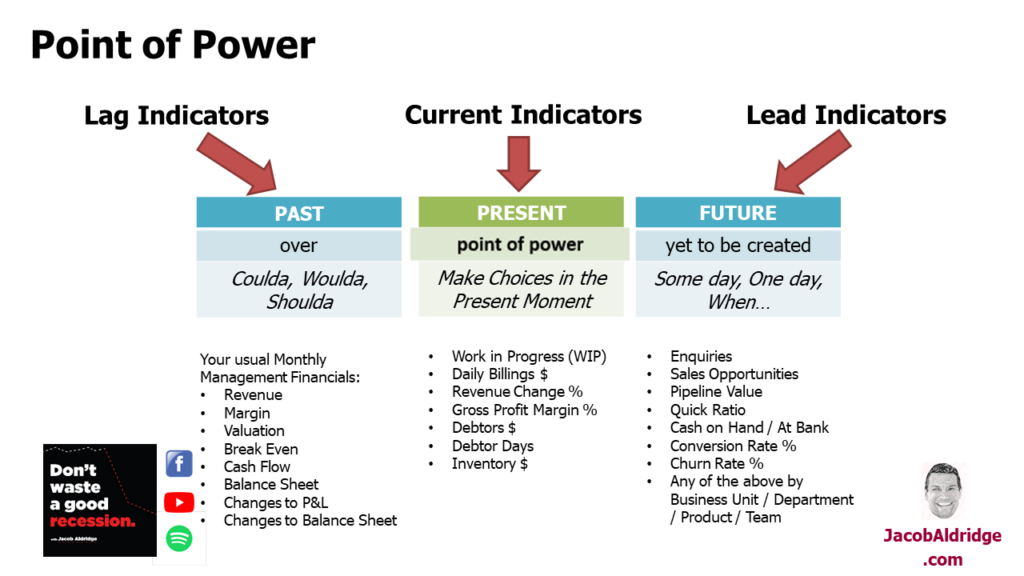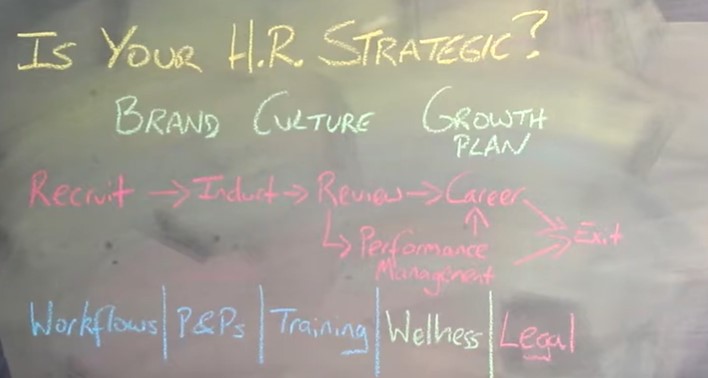Click here to take my Recession Readiness Diagnostic
DATELINE: Taronga Zoo, Sydney Australia
A well known economic viewpoint says that there are four types of economies:
- Developed Countries
- Developing Countries
- Argentina, and
- Japan.
If you’ve checked your stock portfolio this week, you’ll know that #4 is on the fritz again. Here’s what that means for your business. (And if, like me, you think worry is premature – register for my “Let Go to Grow” seminar next Thursday, or skip to “Is Your HR Strategic?” by clicking here.)
What You Need to Do Today
Take 5 minutes to stress test your business and review any blind spots or weaknesses you may have around management, market, mindset, and money if there are indeed tough times ahead.
Otherwise, nothing significant. Unless you trade with Japan.
The trigger this week seems to have been the Bank of Japan raising official interest rates to … “around 0.25%”. While seemingly negligible, that’s an aggressive move in the context of lost decades and has seen the Yen strengthen enormously.
If your immediate thought was “I’d love to have a mortgage at 0.25%”, that’s part of why this blip has been so widespread – a LOT of people have been playing the “Yen-carry” game where they borrow Yen at ~0.0% to invest in other assets in other currencies. AI darling Nvidia (NVDA) is down 20% from a month ago in US Dollars. Measured in JPY, it’s down by 33% in just over four weeks.
Cheap debt x Frothy Tech Stocks x FX Risk = Ouch! But it’s too early too tell if this is the goose flying through the open window of the speeding car.
What You Need to Monitor
Stock markets are a lead indicator of the overall economy. Think about investing – whether you’re buying or selling today, it’s based on what you believe will happen with that asset in the future. When markets drop precipitously, it’s an indication that prices (which represent the wider economy) will be lower in the future. But it’s also possible for fear to creep in and over-correct.
So keep an eye on:
- Share prices. During the Covid Recession these were only a 1 month lead indicator of the SME economy; during the Global Financial Crisis they were a more-typical 6 month forewarning. But jumps between +10% and -10% are more noise than signal.
- The Yield disinversion between US Treasury 2 year Bonds and 10 year Bonds. This flipped last week, and may be a sign that a US recession is likely… but it may cause a downturn rather than predict a downturn. Some of this week’s sell-offs are in response to this yield inversion – if everyone thinks a downturn is likely, some people sell in anticipation, and it becomes a self-fulfilling prophecy. This metric last flipped in 2022 right before job growth and stock market all time highs, which could mean it’s no longer significant or may be lingering consequences of the pandemic’s L-Shaped recession bail-outs.
- Your personal business indicators. See the list below, which comes from this video “Benchmark Business Indicators during the Coronavirus Recession”. Your personal numbers are way more important than the price of Nvidia stock. And if the situation does worsen for you, know that this isn’t my first (or even second) rodeo.

Where You Can Go to Learn More
If you have an audience of business owners who are worried (clients, members, suppliers) – consider partnering with me and running a presentation on the topic. These can be delivered anywhere in the world – after all, in 2022 I was nominated to the Virtual Speakers Hall of Fame in America for my work on recession communication to business owners.
If you want to learn more for yourself, my Critical Recession Content playlist starts with a deep dive video “How Does a Typical Recession Progress”. Ask yourself – based on 500 years of modern economic cycles, does it feel like the dominos are falling right now?
Your Balance Sheet. Ignore the news. Thrive no matter what, from the inside out. And right now the #1 focus is Cash and consciously deciding whether to invest it wisely or hold it in reserve.
Which should be fairly easy. As long as you weren’t betting on a weak Yen to last forever…
Blackboard Fridays Episode #74
Is Your HR Strategic?
The most important function in your business is HR. And yet so many SMEs – despite talking about how their people are their greatest asset – failed to make this function flow.
In my experience, having implemented many end-to-end projects on this topic and helped hundreds of businesses with key components, the failure often flows from confusing the many different elements of an HR function and (as your business grows) of a HR role.
This week, in Blackboard Fridays, we’re going to talk about a whole lot of these different areas to help you understand the things you need to be doing in HR and some of the options you have to turn your HR from an administrative function that costs a business money to a strategic function that actually demonstrates your investment in your people, those people that you value so much.
HR Level 1: The Operational Essentials
We start here at the central line of this framework.

We can see to a degree the career progression of your team – though not all will need Performance Management, and hopefully very few will Exit.
In much larger businesses than yours, each of these different steps within that will be covered by a separate person – perhaps even their own team.
In a micro business (<12 employees when the business owner is the person responsible for all of HR) it’s important you find some time each year to perform and improve those specific tasks. I’ve discussed some of these elements in other episodes, and you might enjoy this Case Study from 2023 where I talked about a project to automate and implement many changes for Recruitment and Onboarding.
- Episode 99, Get Smart: Recruiting Without Recruiters
- Episode 32, How to Conduct a Training Needs Analysis for your Team
- Episode 9, R ‘n’ R – Roles and Responsibilities Part 3
- Episode 70, How to Progress the Careers of your Team
HR Level 2: The Strategic Layer
Now, as your business has grown, you have the opportunity to build different elements. You can move beyond operational essentials, and whether it’s part of or all of an individual’s responsibilities, embed a HR person with some strategic power.
Brand ++ Culture ++ Growth Plan
At a strategic level the best HR people are working with you on things like Brand, Culture, and your Strategic Growth Plan. Yet remarkably, I see a lot of businesses who have an HR person or an office manager with HR responsibilities and they’re not involving them in some of these key decisions.
How can you plan to grow in your business, which almost always involves recruiting at some point, if you don’t involve the HR person who’s responsible for bringing those people on board?
How can you build a culture and a brand to the external market if you’re not involving your HR person in making sure that they’re recruiting the ideal team member for your business? And that they’re inducting them into the brand so that as that team member performs, they’re spreading the brand and living the culture of your business?!
HR Level 3: The Value Adds
Strategic HR also involves taking responsibility (not necessarily doing) for a range of different tasks across a business – that adds enormous value to your business bottom line, and indeed the equity that you’re building in the business.
You can see why I call this layer “The Value Adds” – they’re not just ‘nice to have’, they add:
- The Workflow Processes. Who is doing what tasks, in what order, and are they as efficient as they can be?
- The Policies and Procedures. Are the manuals we’ve built for our team clear? Are our team working on continually improving them?
- Training is (amazingly to me) a function that a lot of businesses keep separate. You have a training person and a HR person and the two don’t talk to each other! Your HR person needs to know the Training plan and system. They need to be involved because they’re the ones who are going to be saying, “The team need these skills.”
- Wellness is not a buzzword anymore. It’s now critical if you want to develop your team (and indeed if you want to attract great candidates) that your business embrace a wellness strategy to help them to live the balanced and healthy life they want. And frankly, if your team are healthier, more mindful, more present, more engaged, and have more energy, that can only mean great things for your business. Strategic HR takes that into consideration.
- The last element is Legal. Now, this covers everything from employment contracts to Workplace Health and Safety. Depending on the size and scope of the organization that you run and the industry that you’re in, there may be many other aspects. If you’re large enough to have a separate legal team / somebody with legal responsibilities, it’s critical that your HR person has a relationship with them. Your HR person is going to be involved in so many aspects of each and every one of your team members that if they aren’t clear on the legal obligations of your team members, chances are your team are either not going to be clear or aren’t going to take it seriously.
So do I need a HR person, an Agency, or can I DIY?
Having a full-time, capable, strategic HR person who just manages this is useful. The larger you grow while having one person who has overall responsibility for that career progression, the more efficient and productive that entire process is going to be.
As a generalisation, I’ve usually seen business owners hand over many of the Operational HR tasks to an employee at around 7-8 full time staff, where those responsibilities (like sending employment contracts) are a small part of an overall position description. It’s often only once a business moves past 30 employees that decisions need to be made – “do we hire a General Manager, a Marketing Manager, or a HR Officer next?”.
And there’s no right answer or best solution. If you want to grow your business strategically, then you need to empower either your HR team or your own HR skills. That can be bringing in a coaching team to help your existing team develop improvements. It can be working ongoing with a HR consultancy, to leverage their knowledge but with enough time and attention that it supports your culture. And it can be leaning on outsourced support and, increasingly, SaaS applications that can automate the administrative grunt work to shift more HR time from Red to Green.
Most importantly of all, HR is not just about each individual’s career progression. You need to integrate Human Resources into your brand, culture, and growth plan; and ensure that these different elements of your business are documented, are communicated and are running efficiently.
With love,
Jacob Aldridge
International Business Advisor
WhatsApp +61 427 151 181
Visit my website
Connect on LinkedIn




